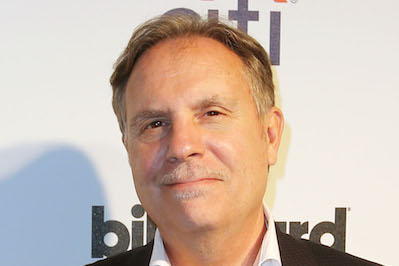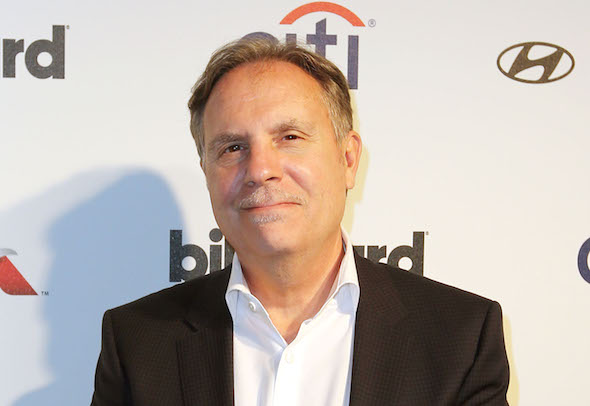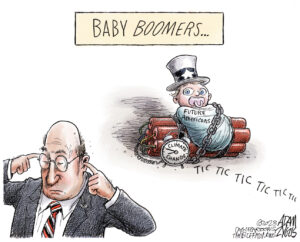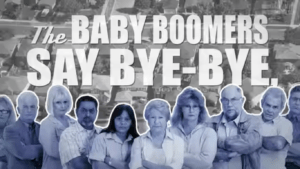Desert Trip Festival Producer Reverses Policy on Seating
AEG Live has reinstated its original plan to allow concertgoers to bring blankets and chairs to the sold-out event in October.

AEG Live Chairman Jay Marciano at the 2015 Billboard Power 100 celebration in Beverly Hills, Calif. (J. Emilio Flores / AP)
Update: After we published Peter Dreier’s piece on complaints over seating arrangements at the upcoming Desert Trip rock festival in Indio, Calif., Truthdig learned that festival producer AEG Live had changed its policy.
As AEG attorney Jason Bernstein explained in a letter to Truthdig, “While Goldenvoice [the festival promoter and a subsidiary of AEG] originally announced that small chairs would be allowed at the concert, the policy changed for a brief period of time. On June 2, the original policy of allowing small chairs was reinstated.”
According to the FAQ on the official Desert Trip website, “Small blankets or towels and/or low back chairs WILL be allowed in designated viewing areas of the venue.”
This will be welcome news to the estimated 70,000 to 75,000 fans per day expected to attend the event, which will be held over two weekends in October and sold out within hours, according to the Los Angeles Times.
Despite repeated requests, AEG Live refused to explain whether the “designated viewing areas” will accommodate all or even 40,000 general admission ticket holders. So it is still unclear whether AEG Live has reversed its “no chairs” policy.
What can angry and aging baby boomers do about one of the latest corporate outrages—AEG Live’s bait-and-switch scam to prohibit fans from bringing their own chairs to the Desert Trip superstar rock festival in October at the Empire Polo Club in Indio, Calif.?
They can carry their folding chairs to the Beverly Hills mansion of AEG Live’s top guy, Jay Marciano, and organize a sit-in. He is, after all, the music presenter’s chairman, so he should be in charge of chairs.
If you haven’t yet heard about this brouhaha, here’s the scoop. AEG Live—also known as Anschutz Entertainment Group, a subsidiary of Anschutz Corp.—is the giant Los Angeles-based festival producer that used a common corporate bait-and-switch trick. First, it lured fans to spend $424 apiece for general-admission tickets to the three-day event with the understanding, posted on the festival’s website, that concertgoers could bring their own seating. Then, after the event sold out—to 75,000 fans a day over two weekends in October—AEG Live posted this notice on the site: “No chairs or blankets will be allowed in the show.”
Los Angeles Times columnist David Lazarus, who first exposed AEG Live’s irresponsible (though perfectly legal) action, observed that the Desert Trip experience is “sure to be a little rough on the hips, backs, knees and necks of some audience members who have seen younger days.”
The festival’s stars include Bob Dylan (who just turned 75), Paul McCartney (73), The Rolling Stones (Mick Jagger and Keith Richards are both 72), The Who (Roger Daltrey is 72 and Pete Townshend 71) and the youngster, Neil Young (70). Given that lineup, Desert Trip, which some have called “Oldchella,” was certain to attract mostly rock fans in their 60s and older who were shocked to learn—after they’d purchased their tickets—that they would be banned from even bringing folding chairs.
“I’m sure most people wouldn’t have bought general admission tickets if they knew that would be the case,” 65-year-old Cindy Reul told Lazarus after she’d paid $1,696 for four tickets. AEG sold about 40,000 general admission tickets—more than half of the 75,000 spots at the polo field.
Thanks to Lazarus’ column, AEG Live agreed to offer refunds to ticket-holders who don’t want to, or can’t, stand up for three days to watch their favorite aging rock stars. But many, like Reul, don’t want their money back. They want to attend the festival. They should stand up for their rights as consumers rather than take this corporate abuse sitting down.
If the irate ticket-holders want their voices heard about the shameful “no chairs” rule, they should take it up directly with Marciano.
Like all protest movements, the tactics have to match the issue. The baby boom generation has used the sit-in many times for many causes. So it would be entirely within boomers’ protest comfort zone to haul their folding chairs and occupy the area in front of Marciano’s home in Beverly Hills. It’s a 3,174-square-foot mansion that he purchased in 2013 for $3.7 million and is now worth more than $5 million. It has, according to Zillow, “breathtaking panoramic views of [the] ocean and city,” so the peaceful protesters could enjoy the vista while making a statement about consumers’ rights.
Picket signs could say, “We Want Our Seats” and “Jay Marciano—Let’s Sit Down and Talk.” If they get to talk to Marciano directly, they might remind him of something he told Billboard magazine in 2014: “What we have to do is get people to go out more often, and delivering a better experience is what is going to do that.”
The aggrieved consumers could also organize a peaceful Occupy AEG Live protest outside Marciano’s office at the company’s downtown Los Angeles headquarters at 425 W. 11th St.
Regardless of where they go to protest, they should also communicate with Marciano—whom Billboard ranks as the 19th most powerful person in the music industry—via Twitter. AEG’s Twitter handle is @AEGworldwide. Protesters could use the hashtag #WeWantOurSeats.
Marciano, who graduated from Harvard and then got a business degree from Dartmouth, has been in the event promotion business for decades, holding top jobs with Madison Square Garden and Universal Concerts, as well as a variety of positions inside Philip Anschutz’s corporate empire. Anschutz appointed Marciano AEG Live’s chairman in 2013.As a music lover and baby boomer himself (born in 1954), Marciano must certainly understand the aggrieved ticket-holders’ ire. But they won’t have much leverage if they wait until the festival is underway to express their concerns. If they show up in Indio with folding chairs or blankets and demand to be let in, the private security guards and local cops will stop them from entering the festival grounds. Instead, they should learn some lessons from past protest movements.
In the 1930s, union activists resorted to sit-down strikes inside factories to pressure big auto companies and other employers to listen to workers’ complaints and negotiate with them for better pay and working conditions. In the 1960s, young civil rights activists organized sit-in protests at Southern lunch counters to challenge Jim Crow segregation. In the 1970s, environmental activists displayed their opposition to dangerous nuclear power plants by “occupying” these facilities around the country—another version of the sit-down and the sit-in. All these actions were successful in drawing attention to the problem and bringing about the changes they were seeking.
AEG Live can certainly afford to let aging baby boomers enjoy their favorite music sitting down—even those in the general admission section. The company is the nation’s second-largest event promoter. It raked in more than $1 billion in revenues last year. In addition to Desert Trip, AEG Live operates 27 events, including the top-grossing Coachella festival, New Orleans’ Jazz Festival, Stagecoach, Denver’s Firefly festival, Electric Forest and Country Superfests in Baton Rouge, La.; Jacksonville, Fla.; and Columbus, Ohio.
AEG Live is part of an even bigger corporate conglomerate, the Anschutz Company, whose owner, Philip Anschutz, is worth $10.8 billion, making him the nation’s 108th wealthiest individual, according to Forbes magazine. His company owns or controls more than 100 event facilities, including Staples Center in Los Angeles; Sprint Center in Kansas City, Mo.; Oracle Arena in Oakland, Calif.; Valley View Casino Center in San Diego; Verizon Theatre at Grand Prairie, Texas; the Colosseum at Caesars Palace in Las Vegas; Target Center in Minneapolis; and BBVA Compass Stadium in Houston, as well as arenas in Sydney, Beijing, Shanghai, Stockholm, Hamburg, Berlin and London. It also owns the Los Angeles Kings, Manchester Monarchs, Ontario Reign, Houston Dynamo and Los Angeles Galaxy sports teams. The company also developed L.A. Live, the 4 million-square-foot, $3 billion, downtown Los Angeles sports, residential and entertainment complex that includes the Microsoft Theater, a movie theater, ESPN broadcast facilities, two mega hotels, a 224-unit luxury condominium complex and the Grammy Museum (Marciano serves on the museum’s board).
Of course, Mariano and AEG Live aren’t the only culprits in the “no seats” conspiracy. More and more music venues have removed most or all of the seating in order to pack in larger crowds. This might be a lucrative business practice, but it is also a form of age discrimination. If today’s baby boomers want to fix the problem, they have to demand that clubs, concert halls and festival sponsors provide adequate seating. No ifs, ands or butts.
Peter Dreier is a professor of politics and chair of the Urban & Environmental Policy Department at Occidental College in Los Angeles. His most recent book is “The 100 Greatest Americans of the 20th Century: A Social Justice Hall of Fame” (Nation Books).
Your support matters…Independent journalism is under threat and overshadowed by heavily funded mainstream media.
You can help level the playing field. Become a member.
Your tax-deductible contribution keeps us digging beneath the headlines to give you thought-provoking, investigative reporting and analysis that unearths what's really happening- without compromise.
Give today to support our courageous, independent journalists.






You need to be a supporter to comment.
There are currently no responses to this article.
Be the first to respond.